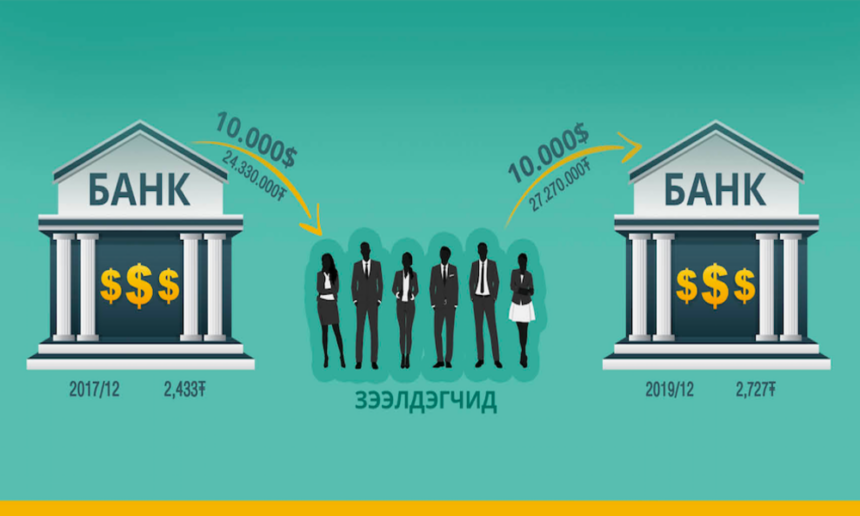This question is being asked more and more often by Mongolian enterprises. Knowing that the lender company is selling their products and services in tugriks, Mongolian commercial banks are constantly pushing the loan exchange to them. With lower interest rates and greater availability, companies are obtaining the loan exchange, but in two-three years especially companies that implement big projects are getting under loan burden. According to the exchange rates while they got loan, even they paid the loan with interest rates several times, some lenders are still in bankrupt and at risk of losing business.
Thus, the loan exchange loss is becoming a real threat to the Mongolian private sector. Some entrepreneurs, through the Mongolian National Chamber of Commerce and Industry (MNCCI), have sent the appeal to commercial banks urging them to change their loan exchange conditions because the exchange rate fall did not depend on entrepreneurs. However, banks did not accept it.
The reality
The Bank of Mongolia’s data shows that at the end of 2018, loan exchange held about one third of all bank’s total loans, almost half of overdue loans and one quarter of non-performing loans. Throughout 2019, some companies have distrained pledged assets, while others have reduced their loan exchange by negotiating with the bank at new rates transfer to tugriks. However, at present, one fifth of total loans, 37% of overdue loans and 23% of non-performing loans are still in loan exchange. The loan exchange carries high risks …

Source: Bank of Mongolia
The success of businesses in Mongolia is largely dependent on whether long-term, low-interest investment sources are available which is, thus, a key factor for the competition in most sectors. That is why even non-exporting companies are still taking loan exchange because of its terms and conditions. The main reason for the shortage of loan tugriks are the relatively small domestic savings.
Companies are expressing that it is unfair to bear the loan exchange loss only by an enterprise alone because the exchange risk is a macroeconomic issue that is consequence of government policy. Here is shown the rise of a dollar rate in the last decade.
US dollar rates from 2009 to 2018 and foreign direct investments to the economy of Mongolia

This also illustrates why enterprises were in difficulty because of their loan exchange. The MNCCI issues a certificate confirming unforeseen or force majeure circumstances. In 2017-2019, gave this certificate to 143 citizens and businesses but only half of them were able to fulfill their contractual obligations due to the rise in exchange rates.
Companies are at a loan payment risk when they take out their loan in the foreign currency but sale the products in the local currency. When the national currency weakens by 10%, the risk of non-repayment of loan exchange companies increases by almost 70% compared to the companies that are on a national currency loan (Schmidt-Eisenlohr, 2017).
This risk affects not only the company, but also the bank itself, which affects the economy of the entire country. Since 2010, the loan exchange deficit in the private sector of the developing countries is growing. Apart from the export-oriented businesses, but as well as non-export businesses are taking loan exchange (Chui et al, 2016).
The resolution
The loan exchange risk depends more on the stability of the local currency rate. Ten years ago, the Mongolian tugrik and the Korean won were ratio in one, but today the tugrik has weakened twice. The Korean economy is booming, meaning that its ratio of foreign and local currency is stable.
This is connected to the fact that in Mongolia, foreign currency is decreasing while local currency is increasing. There are two options for a country to increase its foreign currency earnings: to increase export and attract more foreign investment. Although lending’s can be taken from abroad, it weakens the tugrik if export earnings cannot be increased. The Mongolian case proves it. In December 2012, for the first time in history, the government issued a bond called ‘Chinggis’ on the international market, but failed to diversify its economy and increase exports, resulting in an exchange rate of 1350 MNT per dollar to 2700 MNT seven years later. Since then, the economy has not recouped and the government, on the verge of bankruptcy, got the help under certain conditions from the International Monetary Fund. One of these conditions is the reform of the Mongolian banking system, but it has been failing for three years.
Eastern European countries, which had similar experiences during the 2008 world financial crisis, are minimizing their risk because of tighter financial regulations and tougher loan exchange requirements under the European Union.
It is time for both the Bank of Mongolia and the Mongolian Development Bank to tighten their loan exchange requirements and implement clear policies. Maybe, this should be not allowing non-export businesses to provide loan exchange and providing hedging services, decrease interest rates on loan in tugriks and extending them.
For developing countries such as Mongolia, there is no other option but to increase foreign direct investment to keep exchange rate steady. However, according to the Bank of Mongolia’s balance-of payment statistics, since 2014 foreign direct investment has stagnated to this date. In order to attract foreign and domestic investment, it is necessary to enable fair competition in each sector, to change state owned-companies to stock companies, to reduce the political influence in commercial banks, and to manage that banks and customers are in equal responsibility to exchange rate losses.
2020.01.09












